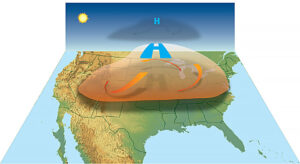From a cognitive and neurobiological perspective, the scientific study of the human brain’s interaction with religion is fascinating. There is now a new branch of neuroscience called neurotheology. This discipline attempts to explain religious experience and behavior in neuroscientific terms.
Dr. Andrew Newberg, director of the Research Marcus Institute of Integrative Health at the Thomas Jefferson University and Hospital in Villanova, PA, has written a book, Principles of Neurotheology, which provides a novel approach to scientific and theological dialogue.
According to Newberg, neurotheology applies science and the scientific method to spirituality through brain imaging studies.
His studies show that both meditating Buddhists and praying Catholic nuns have increased activity in the frontal lobes of the brain. These areas are linked with increased focus and attention, planning skills, the ability to project into the future, and the ability to construct complex arguments.
Interestingly, nuns who pray with words, rather than relying on visualization techniques used in meditation, show increased activity in the language-processing brain areas of the subparietal lobes. Both prayer and meditation correlate with decreased activity in the parietal lobes, which are responsible for processing temporal and spatial orientation.
However, other religious exercises can have the opposite effect on the same areas of the brain.
Dr. Newberg co-authored studies which show that intense Islamic prayer, “which has, as its most fundamental concept, the surrendering of one’s self to God,” reduces the neural activity in the prefrontal cortex, the frontal lobes, as well as the activity in the parietal lobes.
It is thought that the prefrontal cortex is involved in “executive control”, or willful behavior, as well as decision-making. Therefore scientists postulate it is logical that a practice that focuses on abdicating control would result in reduced activity in this brain area.
Dr. Jeff Anderson, Ph.D., a neuroradiologist from the University of Utah School of Medicine in Salt Lake City, along with his research team, examined the brains of 19 young Mormons using a functional MRI scanner.
The participants were asked to what degree they were “feeling the spirit.” Those who reported the most intense spiritual feelings displayed increased activity in the bilateral nucleus accumbens, the frontal attentional, and ventromedial prefrontal cortical loci.
These brain areas are associated with pleasure and reward processing and are also active when we engage in sexual activities, gamble, listen to music, or drug use. The subjects also reported feelings of physical warmth and peace.
Michael Ferguson, who was a bioengineering graduate student at the time, was the author of the first study, said: “When our study participants were instructed to think about a savior, about being with their families for eternity, about their heavenly rewards, their brains and bodies physically responded.
Previous studies showed that spiritual practices raise levels of serotonin and endorphins which are neurotransmitters that are associated with a sense of happiness and well-being. Endorphins work on the opiate receptors in the brain. Thus, Such neurochemical responses to religion lend credence to that dictum, “Religion is the opium of the people.”
Dr. Andersn stated “brain imaging technologies have matured in ways that are letting us approach questions that have been around for millennia,” such as What causes the feeling that someone else is present in the room, or that we are outside of our bodies?
Prof. James Giordano, from the Georgetown University Medical Center in Washington, D.C., explained that activity in the superior parietal cortex, (which is a region in the upper part of the parietal lobe) or the prefrontal cortex increases or decreases, our bodily boundaries change.”
“These parts of the brain control our sense of self in relation to other objects in the world, as well as our bodily integrity; hence the ‘out of body’ and ‘extended self’ sensations and perceptions many people who have had mystical experiences confess to.”
It is noteworthy that a study of Vietnam veterans shows that those who had suffered injuries to the brain’s dorsolateral prefrontal cortex were more likely to report mystical experiences and religious fundamentalism.
in the 1990s, Dr. Michael Persinger, Director of the Neuroscience Department at Laurentian University in Ontario, Canada, designed what came to be known as the “God Helmet.” It was a
device that was designed to simulate religious experiences by stimulating an individual’s tempoparietal lobes using magnetic fields.
Out of the 2,000 participants, only one percent reported feeling, 81 percent felt a “presence of some sort,” and the remaining subjects felt no presence.
Newberg stresses that although neurotheology won’t prove the existence of a “higher power,” it can provide a better understanding of what it means for a person to be religious.“Neurotheology can explore how religion and spirituality affect physical and mental health in terms of beliefs and practices.”










